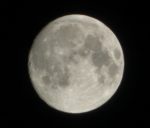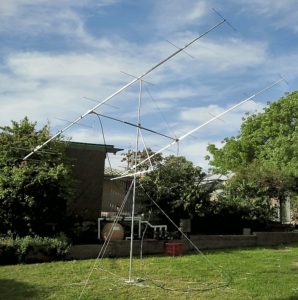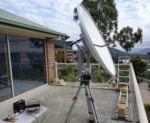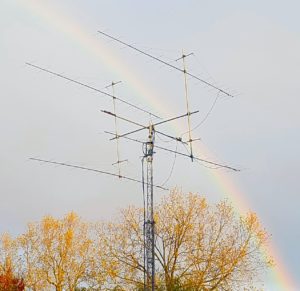Moonbounce (EME)
 Moonbounce or EME (Earth-Moon-Earth) communication presents some of the most significant technical and operating challenges in amateur radio. Since the first two-way amateur QSO via the moon took place in 1960 it has since been followed by many others on every amateur band from 28MHz to 47GHz (with trials now underway at 77GHz).
Moonbounce or EME (Earth-Moon-Earth) communication presents some of the most significant technical and operating challenges in amateur radio. Since the first two-way amateur QSO via the moon took place in 1960 it has since been followed by many others on every amateur band from 28MHz to 47GHz (with trials now underway at 77GHz).
In the early days amateur EME stations needed huge antenna systems, very high power transmitters and complex receiving set-ups. Today EME operation is within reach of most amateurs with a reasonable VHF station capability and enables long distance VHF/Microwave QSOs between many countries across the globe.
The challenge
 This arises from a potent combination of factors that make it an interesting and rewarding challenge:-
This arises from a potent combination of factors that make it an interesting and rewarding challenge:-
- The moon is ~400,000km away
- It is a relatively poor rf reflector
- Relative motion with the earth requires it to be tracked
- Propagation is also subject to Doppler, Libration and Polarisation changes
In practice
EME regularly takes place on all amateur bands from 50MHz up to 47GHz, with 144MHz and 1296MHz by far the most popular bands for activity. Some EME activity has even taken place on the 21 and 28MHz amateur bands.
 A simple 144 MHz Dual 9-element Yagi setup for EME
A simple 144 MHz Dual 9-element Yagi setup for EME
One of the unique characteristics of EME is that it is possible to hear and observe your own transmissions echoed back approximately 2.5 seconds later as the transmitted signal propagates from the earth to the moon, is reflected, and propagates back to the earth.
During any one lunar month (approximately 28 days) any two places on the globe will have mutual visibility of the moon, permitting communications by EME, to take place. At the extremes this may only be for a few minutes, but at shorter separations, such as with Europe or between Europe and North America, the moon may be mutually visible for many hours at a time.
Operating
 Although most modes have been used with EME, until recently CW dominated. However the advent of weak-signal digital modes, such as JT65 and QRA64, has led to a significant rise in their popularity. Because of the higher sensitivity advantage of digital modes, it is possible to use smaller antennas and lower transmit power and this has permitted many more radio amateurs to become involved in EME.
Although most modes have been used with EME, until recently CW dominated. However the advent of weak-signal digital modes, such as JT65 and QRA64, has led to a significant rise in their popularity. Because of the higher sensitivity advantage of digital modes, it is possible to use smaller antennas and lower transmit power and this has permitted many more radio amateurs to become involved in EME.
Activity
Contests, Activity Weekends and DX expeditions ensure there is always plenty of activity to keep EME enthusiasts occupied. The performance of smaller stations need not be limiting, as the larger ones can help you with their greater antenna gains. So have a go – it is not only great for self-training and technical achievements, you can even earn VHF-Microwave DXCCs with it!
 Steerable 4-Yagi 144 MHz array for EME
Steerable 4-Yagi 144 MHz array for EME










